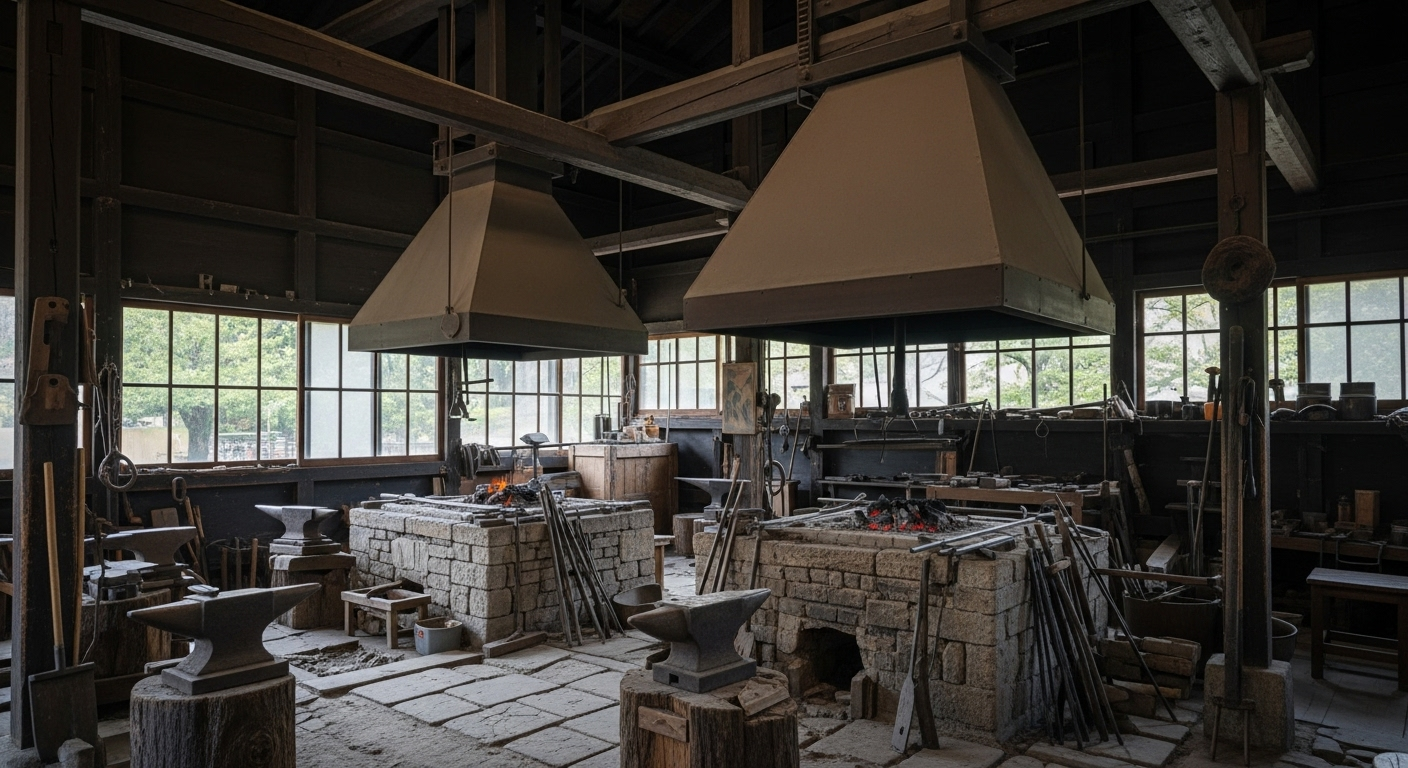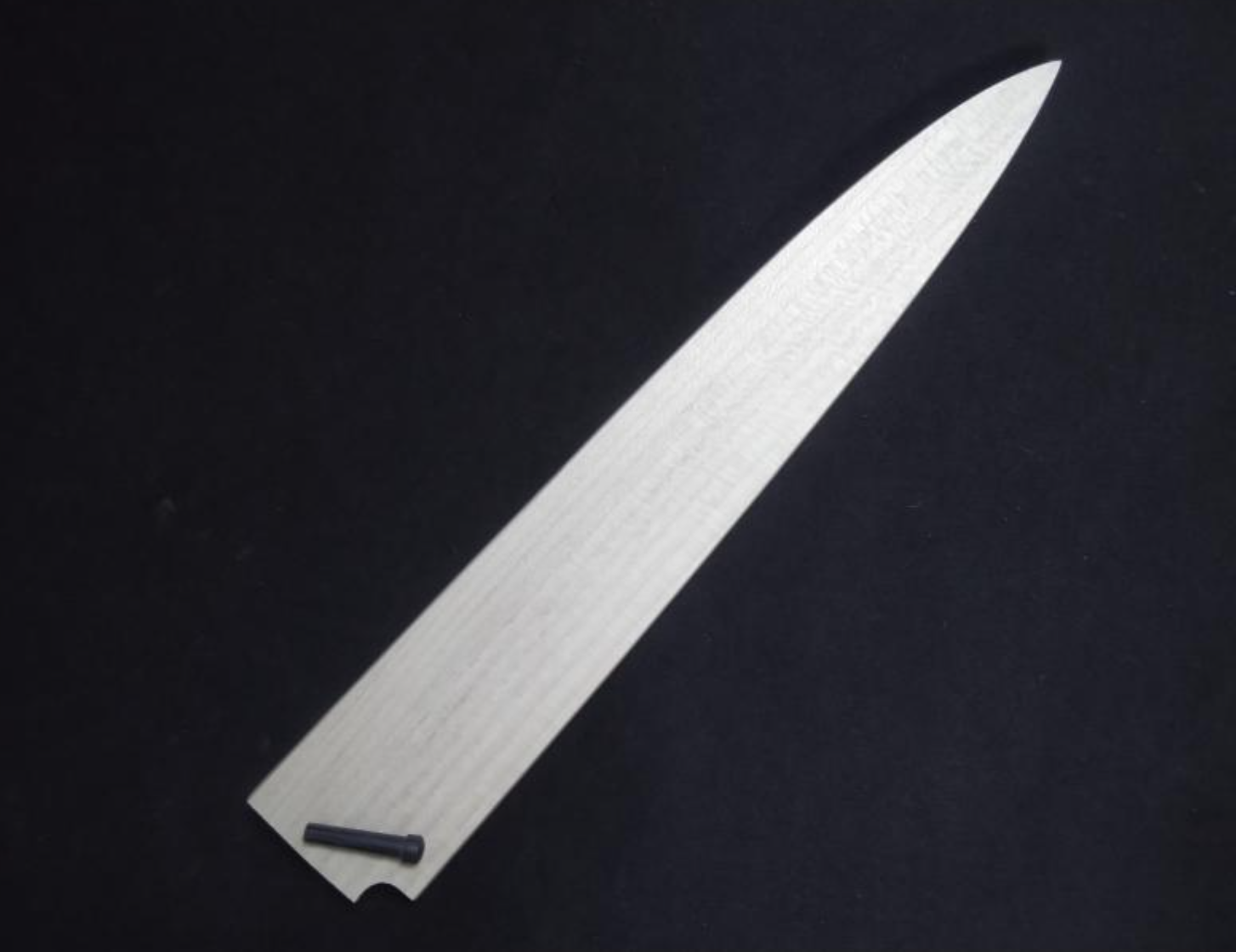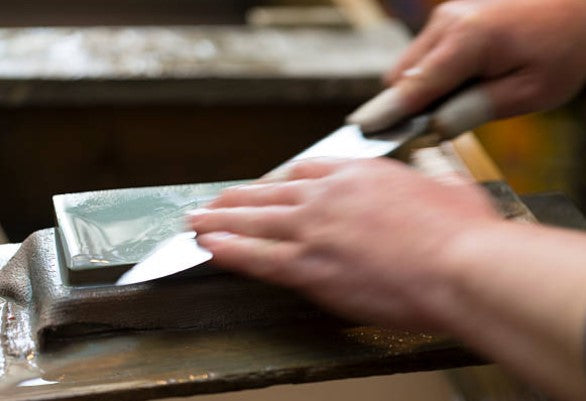
Honbazuke
-
Honbazuke — The Final Edge That Brings a Knife to Life
Did you know that many new Japanese knives aren’t fully sharpened when they arrive?
This is intentional. To protect the blade during transport and allow room for personalization, the final sharpening—called Honbazuke—is left for the craftsman or the user.
In this video, we explore how this traditional technique brings a knife to life, unlocking its true sharpness, character, and spirit.
-
-
The knife isn't quite finished yet!
New knives don't arrive with a perfect edge to prevent damage during shipping, as the blade angle is deliberately not too acute. This page provides a detailed explanation of Honbazuke. -
1. New Kitchen Knives Are Actually not Very Sharp.
-
Did you all know this?
The reasons are,
- To avoid damaging the blade during shipping and transportation, the edge may be dulled.
- To make the edge last longer, the blade angle may be made less acute.
- If the blade angle is too sharp, it can quickly become damaged, even when the knife is new, so the angle may be made less acute.
- To allow for customization and sharpening by the user, the blade may intentionally be made less acute.
What's noteworthy is that many new knives are finished with machine sharpening. As a result, while the knives won't become completely dull, they may not be as sharp as those sharpened by hand using sharpening stones.
-

-
1-1. An example of a new knife sharpened only by machines
-

It's a brand new knife that I just bought.
Most new knives have only the blade edge sharpened by machines. I believe over 90% of the knives sold are finished with machine sharpening. -
1-2. When zoomed in, it looks like this.
-

Only the tip of the blade has sharpening marks in a vertical line.
Since the machine's grinding stone rotates vertically, it leaves vertical scratches on the blade. -
1-3. This makes it quite clear.
-

By the way, the sharpness of this knife is average. It's not completely dull, but compared to a knife sharpened with a finishing stone, its sharpness might not be considered particularly good.
-

2. Definition of Honbazuke
Literally, Honbazuke means "to put on a real blade." Here, "real" refers to sharpening the blade of a kitchen knife to the extreme limit to maximize its functionality.
-

3. Purpose and Effects of Honbazuke
Why is Honbazuke so important? The answer lies in the two main effects achieved by Honbazuke: "improved sharpness" and "sustainability." Just as a professional chef selects the best ingredients, an important factor determining the quality of a dish is the quality of the tools used. The process of sharpening a knife is a kind of dialogue between the knife and the user. The sharpener uses the whetstone to breathe new life into the knife, paying close attention to the knife's material, shape, and the user's needs. Through this delicate process, the knife is transformed from a simple cutting tool to a partner in the pleasure of cooking.
-

4. Historical Background
For hundreds of years in Japan, great importance has been placed on sharpening cutlery, dating back to the days when samurai regarded their swords as their most trusted weapons. Hon-ha-azuke is a technique that has been developed and refined since those times. The craftsmen infuse each stroke of the blade with their spirit, sharpening it as if they were sharpening their own lives. This spirit has been passed down to modern knife making.
-
5. What Exactly Does Honbazuke Do?
-
Japanese knives sold generally, whether for home or professional use, have the shape depicted by the black line in the figure.
(For the sake of clarity, the figure has been exaggerated considerably.)
-

-
A kitchen knife in this state retains the same shape as it had when it left the factory. Even if you use a new knife in this condition, you will not be able to achieve the knife's original sharpness.
In order to achieve the original knife's sharpness, it is necessary to remove the extra gray parts shown in the figure.
This process is called Honbazuke.
-
6. Honbazuke for Single-Edged and Double-Edged Knives at KIREAJI
At KIREAJI, we apply Honbazuke for both single-edged and double-edged knives. Since the structure of single-edged and double-edged knives differs, the Honbazuke methods also vary.
-
Honbazuke of Single-Edged Knives
For single-edged knives, to make it easier to sharpen the blade on the whetstone, we perform a flat grind on the cutting edge using a coarse whetstone. Additionally, this flat grind allows us to make the edge as sharp as possible. As a result, the cutting performance improves significantly. We also apply a secondary bevel, but it is so fine that it's often invisible to the eye—an extremely small bevel (called "Itoha").
-
Honbazuke of Double-Edged Knives
For double-edged knives, we only sharpen the cutting edge. To enhance cutting performance, we sharpen it at an even sharper angle than before. This allows for better penetration into the food, enabling cuts with less force.
-
Important Notice Regarding Honbazuke
At KIREAJI, we provide Honbazuke—the final sharpening process—upon request from our customers. However, please note that this Honbazuke is offered purely as a service and is not intended to be a perfect final finish.
There are two main reasons why we do not apply Honbazuke by default. First, to prevent damage to the blade edge during transportation. Second, because we believe that a knife is a tool meant to be finished by the user, and we hope our customers will enjoy that process. We value the flexibility of adjusting the blade to suit your desired sharpness and intended use, allowing you to create your ideal knife over time.
At KIREAJI, Honbazuke is carried out by hand, with care and responsibility, by staff at the Shiroyama Knife Workshop. Therefore, unlike the extremely precise finishing done by traditional master sharpeners, please understand that this is a practical initial sharpening. It is offered with the intention that you, the customer, will perform the final adjustments to pursue your own preferred sharpness.
One of the unique appeals of Japanese knives is that you can experience the sharpening process yourself, and achieve a cutting edge that truly suits your hand and use. A knife is a tool that grows and evolves with you through use. We hope you enjoy the process of creating a knife that is uniquely your own.

FAQ About Honbazuke

Q1. What is “Honbazuke”?
Honbazuke is a traditional Japanese hand-sharpening method that brings out the full potential of a knife’s cutting edge. Unlike mass-produced blades, which are often given a duller factory edge for safety in shipping, a Honbazuke finish is applied by skilled craftsmen who manually hone the blade to a fine angle. The result is an edge of maximum sharpness, precision, and performance.
Q2. Why doesn’t my new knife feel sharp?
Many new knives are intentionally finished with a slightly blunt angle to protect them during shipping and to let the owner customize the edge to their preference. At KIREAJI, however, every knife is finished with the Honbazuke method. This means it arrives sharp and ready for immediate use, though the edge may continue to improve after your first personal sharpening.
Q3. How often should I replace my kitchen knife?
Rarely. A well-crafted Japanese knife can last for decades if it is properly cared for. Regular sharpening, mindful handling, and proper storage will restore and preserve its edge for many years. Replacement is only necessary if the blade becomes excessively thin after repeated sharpening or shows structural damage.
Q4. Is Honbazuke the same as factory sharpening?
No. Factory sharpening is typically done by machine for speed and efficiency. Honbazuke, on the other hand, is a manual process involving multiple stages of hand-honing performed by skilled craftsmen. This results in a sharper, finer, and more durable edge that reflects true artisanal care.
Q5. What makes KIREAJI’s Honbazuke special?
At KIREAJI, we combine tradition with accessibility. While many Japanese knives are shipped without a final edge, we provide a complimentary Honbazuke finish so you can enjoy immediate sharpness from the very first cut. Over time, as you sharpen and use your knife, the edge evolves uniquely to reflect your personal style — transforming the knife into a lifelong companion.

KIREAJI Complimentary Services
Every knife includes a hand-fitted magnoliasayafor safe storage. Upon request, we offer a complimentaryHonbazukefinal hand sharpening—giving you a precise, ready-to-use edge from day one.

The Soul of Craftsmanship
-
Breathing Life Into the Blade — The Art of Sharpening
Sharpening a knife is not merely about restoring its edge. It is an act of breathing life into steel, turning a tool into a trusted partner in the kitchen.
-
In traditional Sakai craftsmanship, there are over 30 individual steps in the sharpening process. Each step has a precise role, and if even one is neglected, the knife’s sharpness, durability, and character are compromised. This relentless attention to detail is what creates an edge that feels alive in the hands of its user.
-
For us artisans, sharpening is more than technique—it is a dialogue with the tool, a ritual of respect. A finely honed blade preserves the essence of ingredients, allowing flavors, aromas, and textures to shine. But as every cook knows, sharpness inevitably fades with use. A dull blade not only loses function but also diminishes the joy of cooking.
-
When the blade is carefully re-sharpened, its “life force” is restored. The moment a dulled knife glides once again through ingredients, the entire culinary experience is reborn. Cooking becomes smoother, more intuitive, and deeply satisfying.
-
Sharpening is not difficult—it is an expression of care. By taking time to maintain your knife, you not only extend its life but also create a deeper bond with your craft. Each stroke on the whetstone is both maintenance and meditation, a chance to reflect in the midst of daily life.
-
Through this act, the knife is revitalized, and so too is the joy of cooking. That is why we believe: a truly sharp blade carries not only an edge, but also the spirit of its maker and its user.

Experience the sharpness trusted by 98% of Japan’s top chefs — handcrafted in Sakai City.
Through our exclusive partnership with Shiroyama Knife Workshop, we deliver exceptional Sakai knives worldwide. Each knife comes with free Honbazuke sharpening and a hand-crafted magnolia saya, with optional after-sales services for lasting confidence.
KIREAJI's Three Promises to You
-

1. Forged in the Legacy of Sakai
From Sakai City—Japan’s renowned birthplace of professional kitchen knives—each blade is crafted by master artisans with over six centuries of tradition. Perfectly balanced, enduringly sharp, and exquisitely finished, every cut carries the soul of true craftsmanship.
-

2. Thoughtful Care for Everyday Use
Every knife includes a hand-fitted magnolia saya for safe storage. Upon request, we offer a complimentary Honbazuke final hand sharpening—giving you a precise, ready-to-use edge from day one.
-

3. A Partnership for a Lifetime
A KIREAJI knife is more than a tool—it is a lifelong companion. With our bespoke paid aftercare services, we preserve its edge and beauty, ensuring it remains as precise and dependable as the day it first met your hand.











